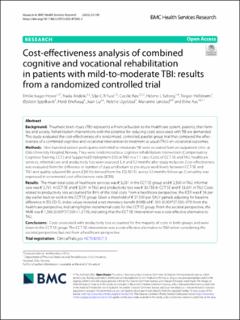| dc.contributor.author | Howe, Emilie | |
| dc.contributor.author | Andelic, Nada | |
| dc.contributor.author | Fure, Silje Christine Reistad | |
| dc.contributor.author | Røe, Cecilie | |
| dc.contributor.author | Søberg, Helene L. | |
| dc.contributor.author | Hellstrøm, Torgeir | |
| dc.contributor.author | Spjelkavik, Øystein | |
| dc.contributor.author | Enehaug, Heidi | |
| dc.contributor.author | Lu, Juan | |
| dc.contributor.author | Ugelstad, Helene | |
| dc.contributor.author | Løvstad, Marianne | |
| dc.contributor.author | Aas, Eline | |
| dc.coverage.spatial | Norway | en_US |
| dc.date.accessioned | 2022-08-22T07:09:26Z | |
| dc.date.available | 2022-08-22T07:09:26Z | |
| dc.date.created | 2022-03-02T08:27:05Z | |
| dc.date.issued | 2022-02-12 | |
| dc.identifier.issn | 1472-6963 | |
| dc.identifier.uri | https://hdl.handle.net/11250/3012796 | |
| dc.description.abstract | Background: Traumatic brain injury (TBI) represents a fnancial burden to the healthcare system, patients, their families and society. Rehabilitation interventions with the potential for reducing costs associated with TBI are demanded. This study evaluated the cost-effectiveness of a randomized, controlled, parallel group trial that compared the effectiveness of a combined cognitive and vocational intervention to treatment as usual (TAU) on vocational outcomes.
Methods: One-hundred sixteen participants with mild-to-moderate TBI were recruited from an outpatient clinic at Oslo University Hospital, Norway. They were randomized to a cognitive rehabilitation intervention (Compensatory Cognitive Training, CCT) and Supported Employment (SE) or TAU in a 1:1 ratio. Costs of CCT-SE and TAU, healthcare services, informal care and productivity loss were assessed 3, 6 and 12 months after study inclusion. Cost-effectiveness was evaluated from the difference in number of days until return to pre-injury work levels between CCT-SE and TAU and quality-adjusted life years (QALYs) derived from the EQ-5D-5L across 12 months follow-up. Cost-utility was expressed in incremental cost-effectiveness ratio (ICER).
Results: The mean total costs of healthcare services was € 3,281 in the CCT-SE group and € 2,300 in TAU, informal care was € 2,761 in CCT-SE and € 3,591 in TAU, and productivity loss was € 30,738 in CCT-SE and € 33,401 in TAU. Costs related to productivity loss accounted for 84% of the total costs. From a healthcare perspective, the ICER was € 56 per day earlier back to work in the CCT-SE group. Given a threshold of € 27,500 per QALY gained, adjusting for baseline difference in EQ-5D-5L index values revealed a net monetary beneft (NMB) of € -561 (0.009*27,500–979) from the healthcare perspective, indicating higher incremental costs for the CCT-SE group. From the societal perspective, the NMB was € 1,566 (0.009*27,500-(-1,319)), indicating that the CCT-SE intervention was a cost-effective alternative to TAU.
Conclusions: Costs associated with productivity loss accounted for the majority of costs in both groups and were lower in the CCT-SE group. The CCT-SE intervention was a cost-effective alternative to TAU when considering the societal perspective, but not from a healthcare perspective. | en_US |
| dc.description.sponsorship | This research was funded by The Research Council of Norway, Grant number 256689/H10. | en_US |
| dc.language.iso | eng | en_US |
| dc.publisher | BMC | en_US |
| dc.relation.ispartofseries | BMC Health Services Research;22, Article number: 185 (2022) | |
| dc.rights | Navngivelse 4.0 Internasjonal | * |
| dc.rights.uri | http://creativecommons.org/licenses/by/4.0/deed.no | * |
| dc.subject | Traumatic brain injuries | en_US |
| dc.subject | Health economics | en_US |
| dc.subject | Clinical trials | en_US |
| dc.subject | Vocational rehabilitation | en_US |
| dc.title | Cost-effectiveness analysis of combined cognitive and vocational rehabilitation in patients with mild-to-moderate TBI: results from a randomized controlled trial | en_US |
| dc.type | Peer reviewed | en_US |
| dc.type | Journal article | en_US |
| dc.description.version | publishedVersion | en_US |
| dc.rights.holder | © The Author(s) 2022 | en_US |
| dc.source.articlenumber | 185 | en_US |
| cristin.ispublished | true | |
| cristin.fulltext | original | |
| cristin.qualitycode | 2 | |
| dc.identifier.doi | https://doi.org/10.1186/s12913-022-07585-3 | |
| dc.identifier.cristin | 2006860 | |
| dc.source.journal | BMC Health Services Research | en_US |
| dc.source.volume | 22 | en_US |
| dc.source.issue | 22 | en_US |
| dc.source.pagenumber | 1-13 | en_US |
| dc.relation.project | Norges forskningsråd: 256689 | en_US |
| dc.relation.project | Norges forskningsråd: 272789 | en_US |

